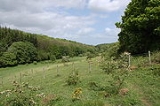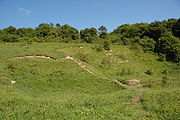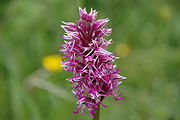
Park Gate Down
Encyclopedia
Park Gate Down is a stretch of chalk downland near Elham
in East Kent
. The site is owned and managed as a nature reserve by the Kent Wildlife Trust
and is also listed as a Site of Special Scientific Interest
(SSSI) and a Special Area of Conservation
(SAC). On 21 May 2007 the reserve was renamed The Hector Wilks
Reserve in memory of this local botanist who had been involved with the reserve from its inception.
 Park Gate Down is located at 51°10′16"N 01°06′10"E (Ordnance Survey reference ) and covers seven hectares on the eastern slopes of a dry valley on the dip slope of the North Downs
Park Gate Down is located at 51°10′16"N 01°06′10"E (Ordnance Survey reference ) and covers seven hectares on the eastern slopes of a dry valley on the dip slope of the North Downs
. The reserve is predominantly chalk grassland although the eastern fringes consist of a mixture of woodland and scrub which is partially situated on a layer of clay with flints that caps the chalk. In the south eastern corner of the reserve is a disused chalk pit and the western and northern area of the reserve borders on Elham Park Wood. To the south of the reserve is an area of land managed under the Countryside Stewardship Scheme
which is being reverted from arable land to chalk downland.
. However, fine, less vigorous grasses are also common such as Sheep's Fescue
(Festuca ovina). The reserve supports a rich flora including many calcicole
s such as Common Milkwort
(Polygala vulgaris), Small Scabious
(Scabiosa columbaria) and Marjoram
(Origanum vulgare). Notable species include Slender Bedstraw
(Galium pumilum), Adder's Tongue
(Ophioglossum), Horseshoe Vetch
(Hippocrepis comosa) and Columbine
(Aquilegia vulgaris).
 Fourteen species of orchid are known to grow at the reserve including some of the UK's rarest species. Park Gate Down is one of only three sites in the UK for the nationally rare Monkey Orchid
Fourteen species of orchid are known to grow at the reserve including some of the UK's rarest species. Park Gate Down is one of only three sites in the UK for the nationally rare Monkey Orchid
(Ochis simia). The orchid was introduced to the site during the twentieth century from another Kentish site and has since flourished with over 100 plants. Park Gate Down also supports the nationally rare Late Spider Orchid
(Ophrys fuciflora) that in the UK is limited to the North Downs in East Kent as well as the nationally scarce Lady Orchid (Orchis purpurea) and Musk Orchid
(Herminium monorchis) of which 72 were counted in 2007.
(Polyommatus coridon), Brown Argus
(Aricia agestis) and Marbled White (Melanargia galathea). The woodland and scrub within and surrounding the reserve attract many feeding and breeding birds including the Nightingale
(Luscinia megarhynchos), European Green Woodpecker (Picus viridis), Great Spotted Woodpecker
(Dendrocopos major), Yellowhammer
(Emberiza citrinella), Linnet
(Carduelis cannabina), Whitethroat
(Sylvia communis), Garden Warbler
(Sylvia borin), Hawfinch
(Coccothraustes coccothraustes), Sparrowhawk (Accipiter nisus) and Hobby
(Falco subbuteo).
and Konik ponies
from September to December and scrub cutting in winter. This prevents tall and vigorous species from dominating, thus creating the species rich grassland characteristic of chalk downland. The woodland is regularly coppiced to provide a range of habitats for insects and birds.
There is road side parking opposite the entrance on the south of the reserve. Although access is unrestricted, visitors are encouraged to keep to the paths to avoid damage to the wild flowers.
Elham
Elham is a village in East Kent situated approximately south of Canterbury and north east of Folkestone in the Elham Valley.-Toponomy:The origin of the village's name has always been a matter of argument. The village is listed in the Domesday Book of 1086 as Alham. This may have derived from...
in East Kent
Kent
Kent is a county in southeast England, and is one of the home counties. It borders East Sussex, Surrey and Greater London and has a defined boundary with Essex in the middle of the Thames Estuary. The ceremonial county boundaries of Kent include the shire county of Kent and the unitary borough of...
. The site is owned and managed as a nature reserve by the Kent Wildlife Trust
Kent Wildlife Trust
Kent Wildlife Trust covers the county of Kent, England, and is one of the largest of the 47 Wildlife Trust organisations in the United Kingdom, the Isle of Man and Alderney...
and is also listed as a Site of Special Scientific Interest
Site of Special Scientific Interest
A Site of Special Scientific Interest is a conservation designation denoting a protected area in the United Kingdom. SSSIs are the basic building block of site-based nature conservation legislation and most other legal nature/geological conservation designations in Great Britain are based upon...
(SSSI) and a Special Area of Conservation
Special Area of Conservation
A Special Area of Conservation is defined in the European Union's Habitats Directive , also known as the Directive on the Conservation of Natural Habitats and of Wild Fauna and Flora...
(SAC). On 21 May 2007 the reserve was renamed The Hector Wilks
Hector Wilks
Hector Wilks was an English botanist and conservationist. He is perhaps best known for rediscovering the Monkey Orchid in Kent at a site near Faversham and subsequently introducing the species to Park Gate Down near Elham...
Reserve in memory of this local botanist who had been involved with the reserve from its inception.
Topography

North Downs
The North Downs are a ridge of chalk hills in south east England that stretch from Farnham in Surrey to the White Cliffs of Dover in Kent. The North Downs lie within two Areas of Outstanding Natural Beauty , the Surrey Hills and the Kent Downs...
. The reserve is predominantly chalk grassland although the eastern fringes consist of a mixture of woodland and scrub which is partially situated on a layer of clay with flints that caps the chalk. In the south eastern corner of the reserve is a disused chalk pit and the western and northern area of the reserve borders on Elham Park Wood. To the south of the reserve is an area of land managed under the Countryside Stewardship Scheme
Countryside Stewardship Scheme
The Countryside Stewardship Scheme is an agri-environment scheme run by the United Kingdom Government set up in 1991.Originally introduced as a five-year pilot project by the Countryside Commission, the scheme aimed to improve the environmental value of farmland throughout England...
which is being reverted from arable land to chalk downland.
Flora
The dominant chalk grassland community at Park Gate Down is CG4 Brachypodium pinnatumCalcicolous grasslands in the British National Vegetation Classification system
This article gives an overview of the calcicolous grassland communities in the British National Vegetation Classification system.-Introduction:The calcicolous grassland communities of the NVC were described in Volume 3 of British Plant Communities, first published in 1992, along with the...
. However, fine, less vigorous grasses are also common such as Sheep's Fescue
Sheep's Fescue
Sheep's Fescue or Sheep Fescue is a species of grass.-General Description:It is a perennial plant sometimes found in acidic ground, for example in the Portlethen Moss, Scotland and mountain pasture, throughout Europe and eastwards across much of Asia; it has also been introduced to North...
(Festuca ovina). The reserve supports a rich flora including many calcicole
Calcicole
A calcicole or calciphyte is a plant that does not tolerate acidic soil. The word is derived from the Latin 'to dwell on chalk'. Under acidic conditions, aluminium becomes more soluble and phosphate-less. As a consequence, calcicoles grown on acidic soils often develop the symptoms of aluminium...
s such as Common Milkwort
Polygala
Polygala is a genus of about 500 species of flowering plants belonging to the family Polygalaceae, commonly known as milkwort or snakeroot...
(Polygala vulgaris), Small Scabious
Scabiosa
Scabiosa is a genus in the teasel Family Dipsacaceae of flowering plants. Many of the species in this genus have common names that include the word scabious; however some plants commonly known as scabious are currently classified in related genera such as Knautia and Succisa; at least some of...
(Scabiosa columbaria) and Marjoram
Marjoram
Marjoram is a somewhat cold-sensitive perennial herb or undershrub with sweet pine and citrus flavours...
(Origanum vulgare). Notable species include Slender Bedstraw
Galium
Galium is a large genus of annual and perennial herbaceous plants in the family Rubiaceae, with 617 known species occurring in the temperate zones of both the Northern and Southern Hemispheres. Most species are known as bedstraw. G...
(Galium pumilum), Adder's Tongue
Ophioglossum
Ophioglossum is a genus of about 25-30 species of Ophioglossales in the family Ophioglossaceae, with a cosmopolitan but primarily tropical and subtropical distribution. The name Ophioglossum comes from the Greek, and means "snake-tongue".Adders-tongues are so-called because the spore-bearing stalk...
(Ophioglossum), Horseshoe Vetch
Horseshoe Vetch
Hippocrepis comosa, known as Horseshoe Vetch, is a flowering plant. It is the sole food of the butterfly species Polyommatus coridon, or the Chalkhill Blue....
(Hippocrepis comosa) and Columbine
Aquilegia
Aquilegia is a genus of about 60-70 species of perennial plants that are found in meadows, woodlands, and at higher altitudes throughout the Northern Hemisphere, known for the spurred petals of their flowers.-Etymology:The genus name Aquilegia is derived from the Latin word for eagle , because...
(Aquilegia vulgaris).

Orchis simia
The Monkey orchid is an orchid species of the Orchis genus. It is known for its pungent odor, which some say is similar to that of feces.-References:...
(Ochis simia). The orchid was introduced to the site during the twentieth century from another Kentish site and has since flourished with over 100 plants. Park Gate Down also supports the nationally rare Late Spider Orchid
Ophrys
The genus Ophrys is a large group of orchids from the alliance Orchis in the subtribe Orchidinae. There are many natural hybrids. The type species is Ophrys insectifera L.1753...
(Ophrys fuciflora) that in the UK is limited to the North Downs in East Kent as well as the nationally scarce Lady Orchid (Orchis purpurea) and Musk Orchid
Musk Orchid
The musk orchid is a commonly occurring species of European orchid.-Status in Britain:Musk orchids have a localised distribution in Britain. Sites where it is found include Ham Hill in Wiltshire....
(Herminium monorchis) of which 72 were counted in 2007.
Fauna
The chalk downland provides an important habitat for insects. Many butterflies thrive at the reserve including the Chalkhill BlueChalkhill Blue
The Chalkhill Blue is a butterfly in the family Lycaenidae.Males have pale silvery-blue wings with black and white border . Females are dark brown, also with the black and white borders...
(Polyommatus coridon), Brown Argus
Brown Argus
The Brown Argus is a butterfly in the family Lycaenidae.-Appearance, behaviour and distribution:Although one of the "Blues" both sexes are brown on the uppersides with a band of orange spots at the border of each wing...
(Aricia agestis) and Marbled White (Melanargia galathea). The woodland and scrub within and surrounding the reserve attract many feeding and breeding birds including the Nightingale
Nightingale
The Nightingale , also known as Rufous and Common Nightingale, is a small passerine bird that was formerly classed as a member of the thrush family Turdidae, but is now more generally considered to be an Old World flycatcher, Muscicapidae...
(Luscinia megarhynchos), European Green Woodpecker (Picus viridis), Great Spotted Woodpecker
Great Spotted Woodpecker
The Great Spotted Woodpecker , Dendrocopos major, is a bird species of the woodpecker family . It is distributed throughout Europe and northern Asia, and usually resident year-round except in the colder parts of its range...
(Dendrocopos major), Yellowhammer
Yellowhammer
The Yellowhammer, Emberiza citrinella, is a passerine bird in the bunting family Emberizidae. It is common in all sorts of open areas with some scrub or trees and form small flocks in winter....
(Emberiza citrinella), Linnet
Linnet
The Linnet is a small passerine bird in the finch family Fringillidae.The Linnet derives its scientific name from its fondness for hemp and its English name from its liking for seeds of flax, from which linen is made.- Description :...
(Carduelis cannabina), Whitethroat
Whitethroat
The Common Whitethroat, Sylvia communis, is a common and widespread typical warbler which breeds throughout Europe and across much of temperate western Asia. This small passerine bird is strongly migratory, and winters in tropical Africa, Arabia and Pakistan.This is one of several Sylvia species...
(Sylvia communis), Garden Warbler
Garden Warbler
The Garden Warbler, Sylvia borin, is a common and widespread typical warbler which breeds throughout northern and temperate Europe into western Asia. This small passerine bird is strongly migratory, and winters in central and southern Africa...
(Sylvia borin), Hawfinch
Hawfinch
The Hawfinch, Coccothraustes coccothraustes, is a passerine bird in the finch family Fringillidae. Its closest living relatives are the Evening Grosbeak from North America and the Hooded Grosbeak from Central America especially Mexico.This bird breeds across Europe and temperate Asia...
(Coccothraustes coccothraustes), Sparrowhawk (Accipiter nisus) and Hobby
Eurasian Hobby
The Eurasian Hobby , or just simply Hobby, is a small slim falcon. It belongs to a rather close-knit group of similar falcons often considered a subgenus Hypotriorchis.-Description:...
(Falco subbuteo).
Management and access
The reserve is divided into three compartments by wire fences. The chalk grassland is maintained through annual grazing by Highland cattleHighland cattle
Highland cattle or kyloe are a Scottish breed of beef cattle with long horns and long wavy coats which are coloured black, brindled, red, yellow or dun....
and Konik ponies
Konik
The Konik or Polish primitive horse is a small horse, a kind of semi-feral horse, originating in Poland. The Polish word konik is the diminutive of koń, the Polish word for "horse" . However, the name "konik" or "Polish konik" is used to refer to certain specific breeds...
from September to December and scrub cutting in winter. This prevents tall and vigorous species from dominating, thus creating the species rich grassland characteristic of chalk downland. The woodland is regularly coppiced to provide a range of habitats for insects and birds.
There is road side parking opposite the entrance on the south of the reserve. Although access is unrestricted, visitors are encouraged to keep to the paths to avoid damage to the wild flowers.

